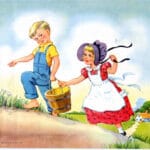Dive into the whimsical world of “Jack and Jill,” a nursery rhyme that has charmed generations. From its simple melody to potential historical significance, this timeless ditty holds a special place in our hearts. Let’s explore the hidden depths of this classic, uncovering its multiple interpretations and the lessons it teaches.
Unraveling the Rhyme: History and Meaning
We all know the story: Jack and Jill go up the hill to fetch water, only for Jack to tumble down, followed by Jill. But where did this simple tale come from, and what does it really mean?
Origins Lost to Time
The origins of “Jack and Jill” remain shrouded in mystery. While the earliest known publication was in 1765 in John Newbery’s Mother Goose’s Melody, its true beginnings are unknown. [https://www.lolaapp.com/jack-jill-lyrics] Some theories connect the rhyme to historical events:
- King Charles I: One theory suggests the rhyme symbolizes King Charles I’s unpopular taxes on liquor, with Jack representing the king and Jill the people.
- French Revolution: Another theory links “Jack and Jill” to the French Revolution, with Jack representing Louis XVI and Jill representing Marie Antoinette, both of whom met a tragic end.
However, these theories are largely speculation. It’s equally possible that “Jack and Jill” emerged from local folklore, a simple tale passed down through generations.
A Tapestry of Interpretations
The beauty of “Jack and Jill” lies in its ambiguity. Its open-ended nature allows for a variety of interpretations. Some see it as a:
- Cautionary Tale: Jack’s fall serves as a reminder to be careful and watch your step.
- Reflection of Life’s Ups and Downs: The hill represents the challenges we face in life, while the fall symbolizes setbacks and the need to persevere.
- Commentary on Gender Roles: The traditional portrayal of Jack fetching water while Jill follows has sparked debate about gender roles and societal expectations.
A Cultural Icon
“Jack and Jill” has transcended its humble beginnings to become a cultural icon, inspiring adaptations in various media, from picture books and cartoons to movies. The rhyme’s simple language, catchy rhythm, and relatable characters continue to captivate young audiences, helping them develop language skills and learn about the world.
Exploring the Rhyme: Lyrics and Analysis
The Lyrics
Jack and Jill went up the hill
To fetch a pail of water.
Jack fell down and broke his crown,
And Jill came tumbling after.Up Jack got, and home did trot,
As fast as he could caper.
He went to bed and bound his head
With vinegar and brown paper.
What Makes it Memorable?
- Simple Rhyme Scheme: The AABB rhyme scheme is easy for children to grasp and remember.
- Repetitive Structure: The repetition of phrases like “Jack and Jill” and “up the hill” reinforces the story and helps with memorization.
- Vivid Imagery: The simple yet evocative language creates a clear picture in the listener’s mind.
“Jack and Jill” for Kids: A Timeless Tale
“Jack and Jill” is more than a silly rhyme; it’s a valuable tool for child development. Its simplicity and engaging storyline make it perfect for introducing young learners to:
- Rhyming: The rhyme’s clear rhyming pattern helps children develop phonemic awareness, a crucial skill for reading.
- Storytelling: The simple narrative structure introduces basic story elements, like characters, setting, and plot.
- Life Lessons: The rhyme subtly teaches children about:
- Safety: The importance of being careful.
- Resilience: Getting back up after a fall.
- Helping Others: The implication that Jill tries to help Jack after he falls.
Decoding the Mystery: What Did Jack Break?
One of the most common questions about “Jack and Jill” is: “What exactly did Jack break?” The rhyme itself states he “broke his crown,” which could have a few interpretations:
- A Literal Head Injury: The most common understanding is that Jack bumped his head during the fall.
- A Broken Bone: Some speculate Jack might have broken a bone, such as a wrist or arm, which would explain his ability to walk home.
- A Symbolic Injury: Some interpret the “crown” as a symbol of pride or achievement, suggesting that Jack’s fall represents a setback or loss of status.
The ambiguity of the injury adds to the rhyme’s intrigue and allows for different interpretations.
Rhyming in “Jack and Jill”: A Closer Look
The rhyming words in “Jack and Jill” play a crucial role in its memorability and musicality. Here are some of the key pairings:
- Jill and hill: These words rhyme perfectly and set the scene, immediately telling us where the characters are headed.
- Water and after: This rhyme highlights the cause-and-effect relationship between Jack’s fall and Jill’s subsequent tumble.
- Crown and down: This pair emphasizes the unfortunate event of Jack’s fall and injury.
These simple rhymes create a delightful rhythm and flow, making “Jack and Jill” a joy to recite and listen to. [https://www.lolaapp.com/jack-jill-lyrics]
The Enduring Appeal of a Simple Rhyme
“Jack and Jill” has captivated audiences for centuries. Its timeless appeal likely stems from:
- Relatability: The themes of facing challenges, making mistakes, and persevering are universal experiences.
- Simplicity: The rhyme’s simple language and straightforward story are easily understood by people of all ages.
- Openness to Interpretation: The rhyme’s ambiguity allows listeners to create their own meanings and connect with it on a personal level.
Like many classic nursery rhymes, “Jack and Jill” offers a glimpse into history, language, and the human experience. While its origins may remain a mystery, its enduring appeal is undeniable.
For more insights into the lives and legacies of iconic figures like Marilyn Monroe, check out our article on how much did marilyn monroe weigh.
















